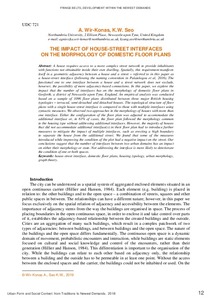Показать сокращенную информацию
1. THE IMPACT OF HOUSE-STREET INTERFACES ON THE MORPHOLOGY OF DOMESTIC FLOOR PLANS
| Автор | Wir-Konas, А. | |
| Автор | Seo, K.W. | |
| Дата внесения | 2019-07-10T07:53:01Z | |
| Дата, когда ресурс стал доступен | 2019-07-10T07:53:01Z | |
| Дата публикации | 2019-05 | |
| ISBN | 978-5-7638-4127-5 | |
| URI (для ссылок/цитирований) | https://elib.sfu-kras.ru/handle/2311/111670 | |
| Описание | Proceedings of the XXV ISUF International Conference “Urban Form and Social Context: from Traditions to Newest Demands” (Krasnoyarsk, July 5–9, 2018) | ru_RU |
| Аннотация | A house requires access to a more complex street network to provide inhabitants with functions not obtainable inside their own dwelling. Spatially, this requirement manifests itself in a geometric adjacency between a house and a street – referred to in this paper as a house-street interface (following the naming convention in Palaiologou et al, 2016). The functional one to one interface between a house and a street network does not exclude, however, the possibility of more adjacency-based connections. In this paper, we explore the impact that the number of interfaces has on the morphology of domestic floor plans in Gosforth, a district of Newcastle upon Tyne, England. An empirical analysis was conducted based on a sample of 1096 floor plans distributed between three major British housing typologies – terraced, semi-detached and detached houses. The topological structure of floor plans with a single house-street interface is compared to those with multiple interfaces using syntactic measures. We observed two approaches in the morphology of houses with more than one interface. Either the configuration of the floor plan was adjusted to accommodate the additional interface or, in 63% of cases, the floor plan followed the morphology common to the housing type without addressing additional interfaces. However, the majority of houses that did not accommodate additional interface(s) in their floor plan had to introduce further measures to mitigate the impact of multiple interfaces, such as erecting a high boundary to separate the house from the additional street. We found that some of the measures introduced while improving the condition of the plot had a negative impact on the street. Our conclusions suggest that the number of interfaces between two urban domains has an impact on either their morphology or state. Not addressing the interface is more likely to deteriorate the condition of one or both spaces. | ru_RU |
| Язык | en | ru_RU |
| Издатель | Siberian Federal University | ru_RU |
| Издатель | Сибирский федеральный университет | ru_RU |
| Тема | house-street interface, domestic floor plans, housing typology, urban morphology, graph theory. | ru_RU |
| Название | 1. THE IMPACT OF HOUSE-STREET INTERFACES ON THE MORPHOLOGY OF DOMESTIC FLOOR PLANS | ru_RU |
| Тип | Conference Item | ru_RU |
| Тип | Conference Paper | ru_RU |
| Контакты автора | А. Wir-Konas, K.W. Seo: Northumbria University, 2 Ellison Place, Newcastle upon Tyne, United Kingdom e-mail: agnieszka.wir-konas@northumbria.ac.uk, kyung.seo@northumbria.ac.uk | ru_RU |
| Страницы | 12 – 20 | ru_RU |
| Место издания | Красноярск | ru |
| Место издания | Krasnoyarsk | en |

